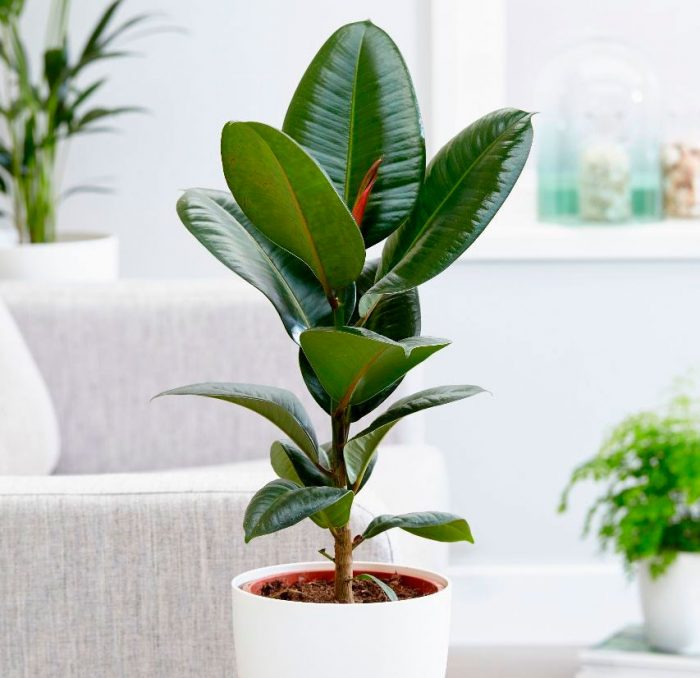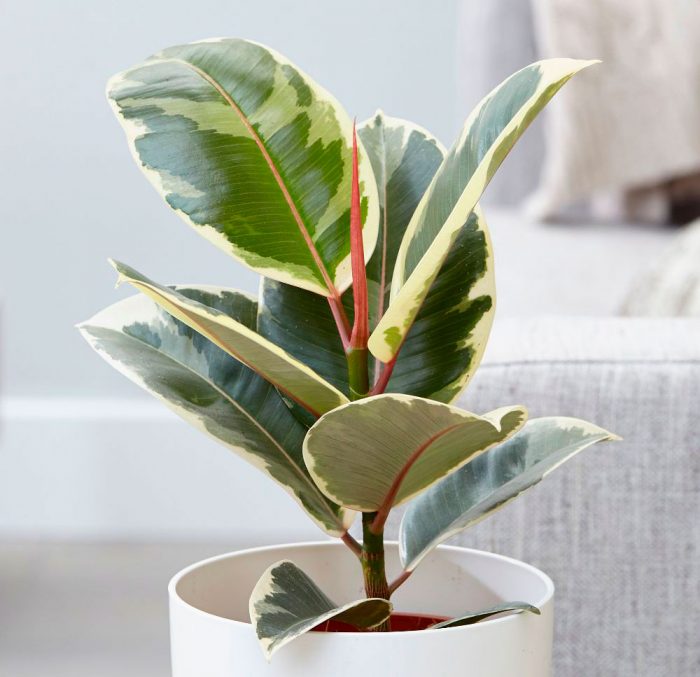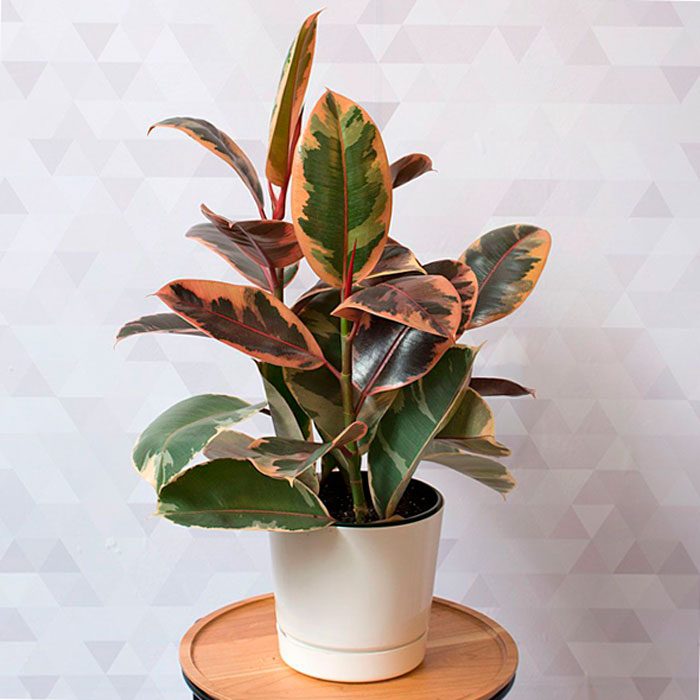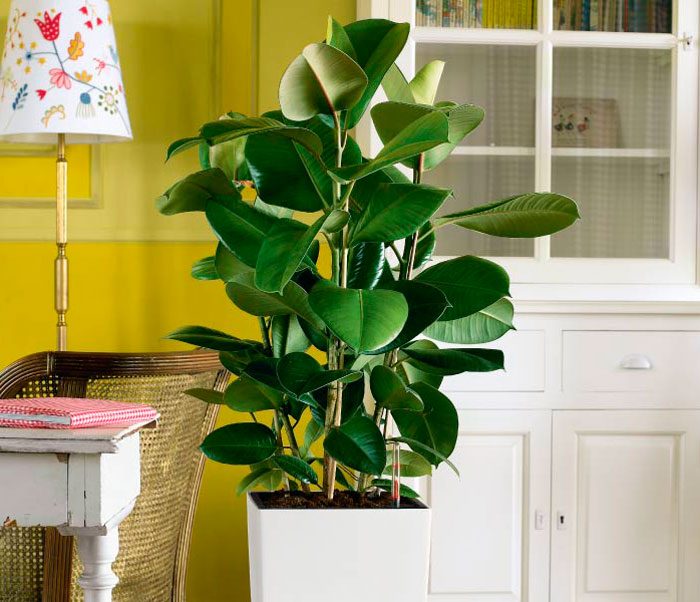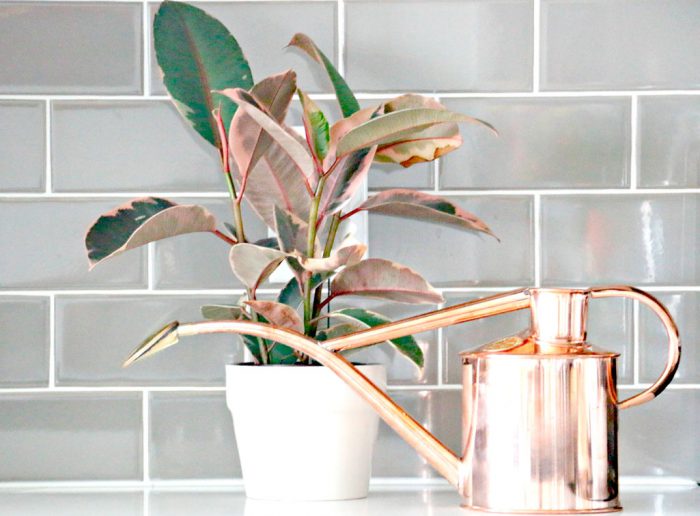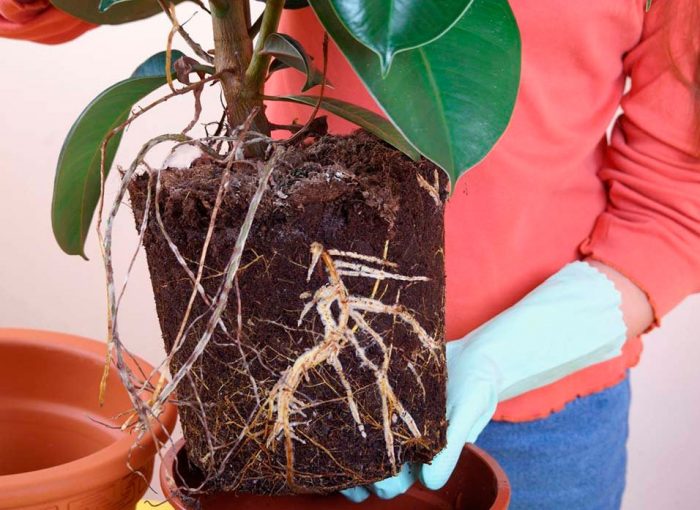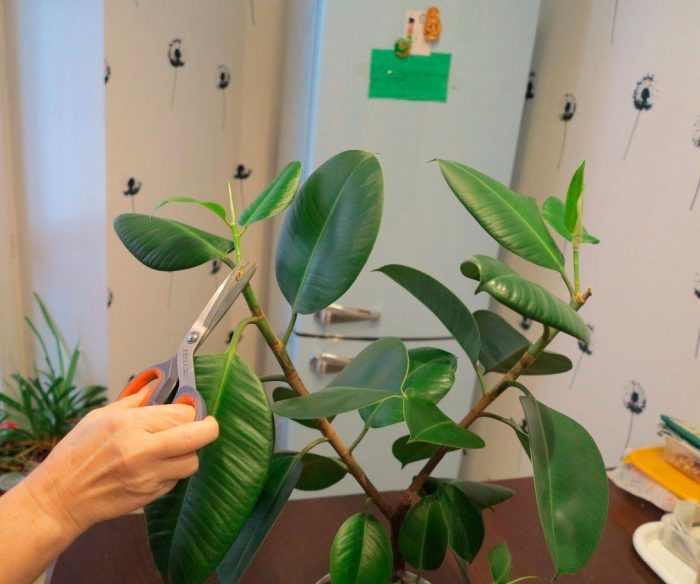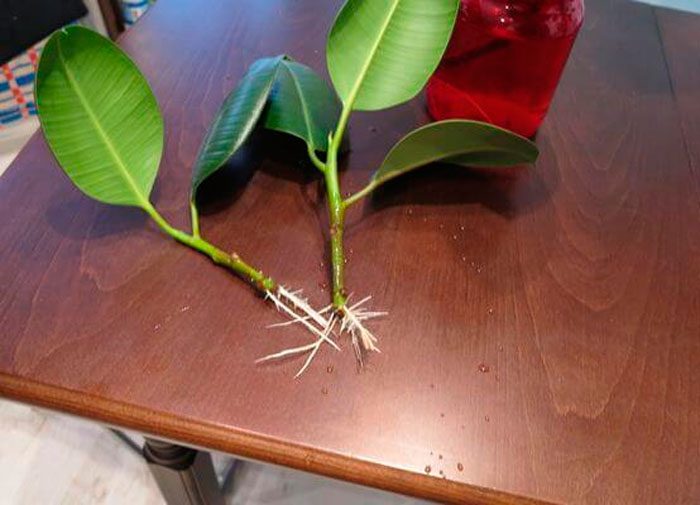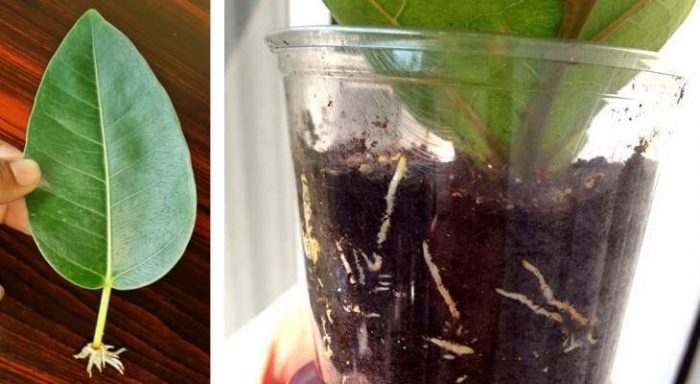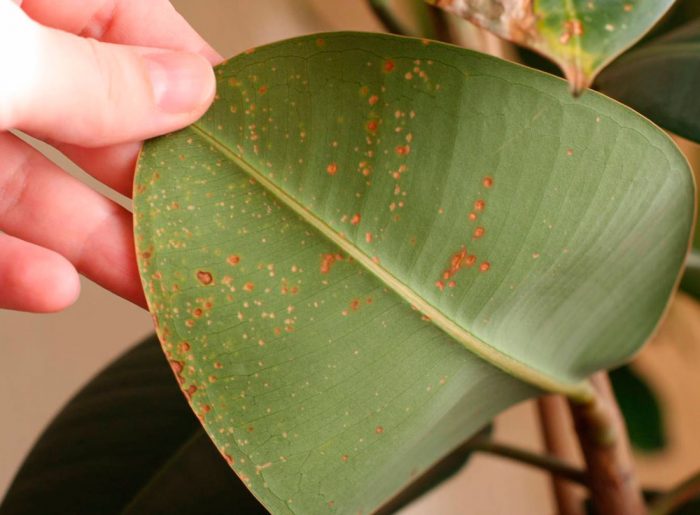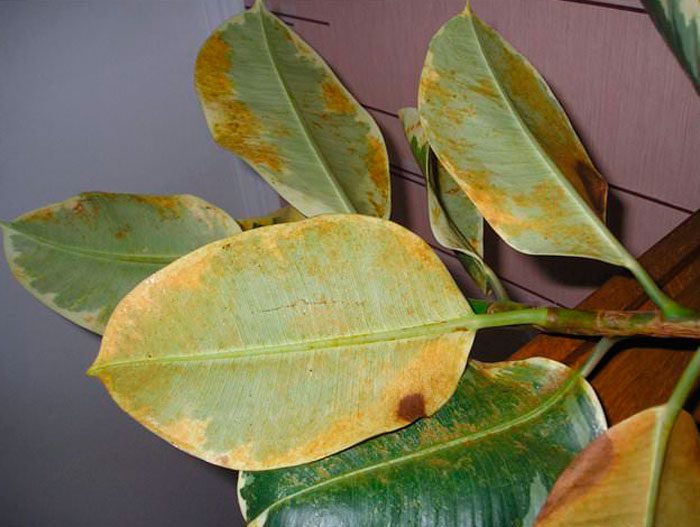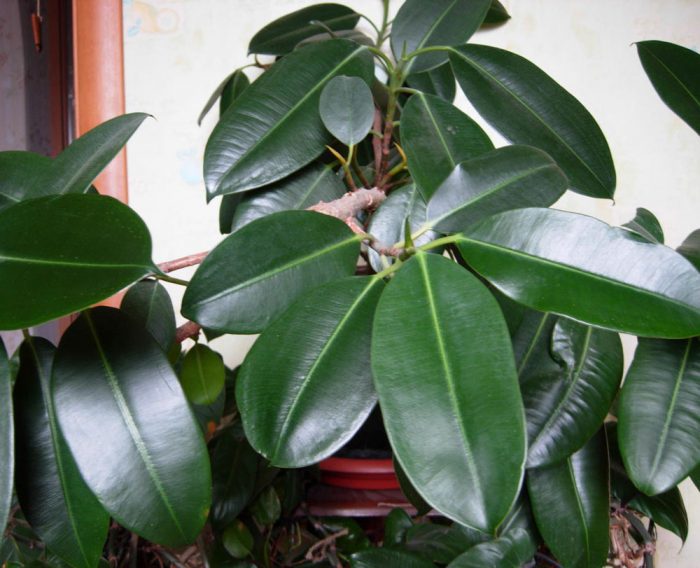Ficus elastica, or rubbery ficus is a species of the genus Ficus of the Mulberry family. This plant comes from the Indonesian islands of Java and Sumatra, and also from the northeastern part of India. This ficus was named rubbery because it has a thick juice, which contains a lot of rubber used for the production of rubber. In the homeland of the elastic ficus by Buddhists, it is revered as a sacred plant. Of all the species that are part of the ficus genus, this species, as well as its cultivars, is most popular with flower growers. However, in the twentieth century, many flower growers considered this plant a blatant symbol of bad taste, and they forgot about it for a long time. However, thanks to Dutch growers in recent years, this beautiful and unpretentious plant has become popular again.
Content
Brief description of cultivation
- Bloom... It is grown as an ornamental deciduous plant.
- Illumination... Can be grown in light shade or in bright, diffused light.
- Temperature regime... During the growing season - from 20 to 25 degrees, and in winter - no colder than 15 degrees.
- Watering... In the warm season - 1 or 2 times in 7 days, and in winter - once a week.
- Air humidity... Should be elevated. In the spring-summer period, the bush must be systematically moistened from a sprayer. Dust from foliage is removed with a damp soft cloth.
- Fertilizer... Ficus is fed 1 time in 15 days from April to September. For this, organic matter and mineral fertilizers with a high nitrogen content are used alternately.
- Dormant period... In October – March.
- Transfer... A young plant needs frequent replanting, which is carried out every year in the spring or in the first summer weeks. More mature bushes are subjected to this procedure 1 time in 2 or 3 years. If the bush is already old, then it is not transplanted, but only the top layer of the soil mixture is replaced annually.
- Reproduction... Layering and cuttings.
- Harmful insects... Aphids, nematodes, scale insects, thrips, mealybugs, yellow and red spider mites.
- Diseases... Root rot, black fungus, cercospora, anthracnose and botrytis.
- Properties... The juice of this plant contains poisonous substances.
Features of rubber ficus
Under natural conditions, rubber ficus can reach a height of about 30 m. It can also grow very wide in width, the fact is that it has aerial roots, they descend from the branches and tree trunk to the surface of the soil and grow into the ground. Thus, they provide the ficus with additional nutrients, and also give it a shape called "banyan tree". Since it has a lot of winding aerial roots, the locals nicknamed it "the snake tree". Alternate large leathery leaf plates of dark green color have an elliptical shape, which has a sharpness at the top. Young leaf plates are wrapped in brownish-red stipules, which dry out very quickly and fly around, immediately after the leaves open. The flowers of this plant are inconspicuous and do not represent any decorative value, however, they are formed only when the bush is pollinated by certain insects, and when grown indoors, this is quite problematic. In this regard, only an adult bush can bloom, which grows in a fairly spacious winter garden. The fruits are spherical syconia, reaching up to 10 mm in diameter, outwardly they are similar to small inedible figs.
More recently, such a ficus was massively grown to obtain rubber from its milky juice. If the ficus juice gets on the skin, it can cause an allergic reaction, irritation or dermatitis, since it contains alkaloids and enzymes in addition to latex. If cuts or wounds appear on the ficus due to animals or humans, then this labeled juice will help them heal very quickly. The height of indoor ficus rarely exceeds 200 centimeters. However, it is not a slow-growing plant, so, in 1 year, under favorable conditions, a bush can add from 0.4 to 0.45 m in height.If it grows to the ceiling, then it can be cut off. In most cases, when growing ficus in indoor conditions, its trunk does not give lateral shoots.
Caring for ficus rubber at home
Illumination
Rubber ficus belongs to light-loving plants, so the light should be bright, but always diffused, since the direct rays of the sun can harm it. For him, you can choose a place in a little shading, but in this case his growth and development will be slower, while be prepared for the fact that the lower foliage will fly around him.
Temperature regime
In the spring-summer period, the bush grows best at an indoor temperature of 20 to 25 degrees. A short-term temperature rise of up to 30 degrees will not do much harm to him. In winter, it is recommended to move it to a cool place, but make sure that the air temperature does not drop below 15 degrees.
Watering and humidity
It is necessary to moisten the soil mixture in the pot only when the top layer dries out by about 2 fingers in depth. On average, in the spring-summer period, watering is carried out 1 or 2 times in 7 days, and in the cold season - once a week. If watering is more frequent, it can cause foliage to fly around.
In spring and summer, to increase the level of humidity, the foliage is systematically sprayed with warm water from a spray bottle, and it is also washed with a moistened soft cloth once every half a month. And once every 30 days, it is advisable to arrange a warm shower for the ficus, while the substrate in the pot must be protected from water by covering it with a film. In winter, it is not recommended to moisten the foliage; instead, it is wiped with a damp swab and removed away from working heating appliances.
Fertilizer
In order for the bush to grow and develop within normal limits, it needs to be fed regularly from April to September once every 15 days.To do this, it is recommended to alternately use liquid organic matter and mineral fertilizers with a high nitrogen content. For example, after watering, a solution of Nitrofoska can be poured under the plant (for 1 liter of water ½ teaspoon of the substance), and after half a month it is fed with mullein infusion, also after watering. Do not let the nutrient mixture get on the surface of the growth buds or foliage. It is impossible to polish sheet plates with chemical agents; in extreme cases, you can use non-alcoholic beer for this.
Transplant of rubber ficus
While the bush is young, it needs an annual transplant, which is carried out in the spring months or in the first summer weeks. An adult bush is transplanted only when absolutely necessary, after its root system becomes very cramped in the container (on average, once every 2 or 3 years). A sign that the soil mixture is depleted and must be replaced with a fresh one is that, after watering, the liquid flows too quickly into the sump.
When choosing a new pot, consider that it should be 50-60 mm deeper and 40-50 mm larger in diameter compared to the old one. If the plant is very old, then during transplantation it can be badly damaged, which will lead to its death. In this regard, experienced flower growers advise not to disturb such a ficus with transplants, but simply regularly change the top layer of soil mixture with a thickness of 30 mm to a fresh one once a year. The composition of an earthen mixture suitable for growing ficus should include peat, leaf and sod soil, as well as river sand (1: 1: 1: 1). If desired, you can purchase ready-made soil mixture for ficus. A universal soil mixture is also suitable for transplanting, but it will be necessary to add a small amount of river sand to it.
Pour a good layer of drainage into the pot, and then carefully remove the flower along with the earthen ball from the old container and transfer it into a new one. Fill all voids with fresh earth mixture so that the pot is full.


Watch this video on YouTube
Pruning
Pruning is needed in order to restrain the growth of the bush, as well as to increase the amount of foliage, because over the years, the lower leaf plates begin to fly around. Often, beginner growers, wanting their ficus to branch, cut off the top of it. However, it does not start branching from this, at best one of the upper buds located on the trunk awakens in it. To achieve more, it is recommended to trim 5–6 internodes. In an overly quickly stretched bush, you can cut off the upper part, root it for a start, and then plant it in the same container. When the stems have reached their maximum height, from your point of view, they will need to be cut again. Pruning should be done in early spring, otherwise the lateral buds will not wake up, but the highest point of growth will begin to grow again. Prune the plant with a very sharp pre-disinfected blade. The milky juice that will stand out after cutting must be removed with running water.
If you want your house to be decorated with a lush ficus bush, then several plants are planted in one container at once. For its cultivation, a slightly shaded place is chosen, while the bush is systematically turned around its axis, this is necessary so that the stems do not bend, as they begin to reach for the light source. If you have planted only one plant in a pot and want to make it more luxuriant, then try to wake up the sleeping buds on the stem by pruning (how to do this is described in more detail above). Also, to increase the splendor of the plant, some growers use the method of piercing the trunk to a depth of 1/3 of its thickness. Such stimulation starts from the top of the trunk, and then gradually goes down.
The upper part of the young bush is tilted down to the maximum, after which it must be fixed.The kidney, which is higher than all the others, awakens and gives a lateral shoot. As soon as this happens, the flower is returned to its normal position.


Watch this video on YouTube
Reproduction methods
Cuttings
Reproduction of rubber ficus by cuttings is one of the most effective and simple ways. Cut obliquely the apical or stem cutting, the height of which should be from 10 to 15 centimeters. All leaf plates are cut off from him, leaving only 1–2 top leaves. Wash off the milky juice from it; for this, the stalk is kept under running water until its release stops. Root it in a container of water. Those leaf plates that remain are rolled up with a tube to reduce the area of evaporation of moisture, and so that they do not unfold, rubber bands are put on them. However, cuttings give roots best when rooting in a soil mixture, but in this case, they must be covered with a transparent plastic bag on top.
As a rule, cuttings cut from a green-leaved variety of rubber ficus give roots very quickly, and there are no problems with them. If you took a stalk from a variegated ficus variety, then before planting for rooting, the cut site must be anointed with heteroauxin or root. They are planted in mini-greenhouses with bottom heating. However, you need to be prepared for the fact that such cuttings will not take root.


Watch this video on YouTube
Propagation by air layers
Variegated ficus forms are best propagated by air layers. Make an incision on the trunk, the depth of which should be equal to 1/3 of its thickness. To prevent the edges of the cut from closing, place a match in it. This place on the trunk should be wrapped with moistened sphagnum, which is wrapped on top with polyethylene; ordinary tape is used to fix it. After the roots are formed at the site of the cut (you can see this through the transparent film), the shoot is cut below the cut with the roots and planted in a separate pot.
Leaf propagation
This breeding method is used extremely rarely, and besides, it is untested (that is, there is no evidence that this method is really effective). If the cut leaf plate is put for rooting in a container with water, then after a while its roots will grow. And after it is planted in the substrate, after a month, a year, two years, this leaf plate will show off in your pot, because it is not able to give shoots.
Diseases and pests
Pests
Rubbery ficus is distinguished by a relatively high resistance to both various diseases and harmful insects. However, spider mites or scale insects very rarely settle on it. If this happens, then it will be necessary to wash the foliage with an infusion of tobacco dust, for the preparation of which 1 liter of water and 4 tbsp. l. dust, a small amount of soap is also added to the mixture. A couple of hours after applying the solution to the foliage, it is washed with clean water. If scale insects have settled on the bush, then before processing, try to remove all pests from it, for this use a regular cotton swab. And remember that those plants whose leaf plates are kept clean cannot suffer from pests, as they bypass them.
Possible problems
Due to improper care or inappropriate keeping conditions with a flower, the following problems may arise:
- Foliage flies... If only the lower leaf plates fall off, then there is no need to worry, because this is a completely natural process associated with the aging of the plant. If not only the lower foliage dies, then the reason for this may be overdrying of a clod of earth in a pot, too frequent watering, poor lighting, a sharp change in temperature or a cold draft.
- Yellow foliage... As a rule, leaf plates first turn yellow, and then die off and fall off. Therefore, see the reasons for yellowing foliage above. However, foliage can also change its color to yellow due to the fact that there are a lot of nutrients in the soil mixture. In this case, rinsing of the substrate is recommended, for this, by means of top watering, such a volume of water is poured into the container, which could fill 3 such empty flower pots in which the ficus grows. After washing, feeding is suspended for 8 weeks. Also, yellowing may be due to the fact that the soil mixture contains a lot of salts, in this case, only transplanting a flower into a fresh substrate will help to correct the situation. The leaves also turn yellow when the ficus grows in an excessively large container, in which case it must be transplanted into a new pot of smaller volume. Also, yellow leaves can be a sign that rot has appeared on the roots. If you smell the soil mixture, then it will smell like rot. In this case, it is necessary to pull the bush out of the container, free its root system from the ground, cut out all decayed areas, after which it is planted in a fresh substrate. However, there are times when a decayed plant cannot be saved.
- The bush does not grow... This may be due to the fact that the ficus is experiencing an acute lack of nutrients, it does not have enough light, or its root system is very cramped in the pot. If you correct the existing errors, then the bush will begin to actively grow again.
Rubbery ficus: benefits and harms
Rubbery ficus is able to quite effectively clean the air in the room from trichlorethylene, phenol and benzene. At the same time, it processes these hazardous substances into sugar and amino acids. In addition, Ayurveda adherents are sure that this plant is able to absorb the fluids of anxiety and anger, thereby purifying the energy of the room. Hindus argue that if a childless couple, who has long dreamed of children, decorates their house with ficus, then soon they will have a baby.
Also, rubbery ficus has medicinal properties that are used in medicine. Means made from its juice and foliage are used to treat mastopathy, as well as to prevent cancer. Also, such drugs are used during the treatment of fibroids and uterine fibroids. Compresses are prepared from the juice, which are used for radiculitis, hemorrhoids, arthritis and osteochondrosis. Asthmatics need to be very careful with this plant, because it releases rubber into the air, which can cause a choking attack.


Watch this video on YouTube

